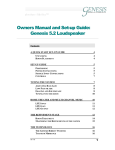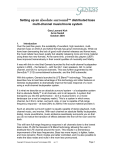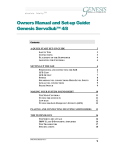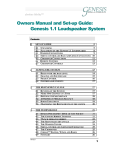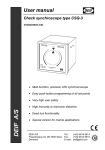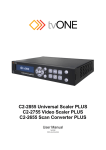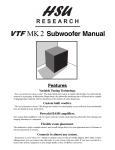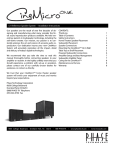Download Genesis I.C.E. 928 User's Manual
Transcript
~ÄëçäìíÉ=Ñ áÇÉäáíó™ Owners Manual and Set-up Guide: Genesis 928 Subwoofer Contents A QUICK START SET-UP GUIDE SAFETY TIPS CONNECTIONS PLACEMENT OF THE SUBWOOFER ADJUSTING THE CONTROLS SETTING-UP THE G928 3 3 3 3 4 5 POSITIONING THE G928 FOR MUSIC POSITIONING THE G928 FOR HOME THEATER 5 6 LFE INPUT LFE GAIN LFE OUTPUT CONNECTING UP YOUR G928 POWER SPEAKER-LEVEL CONNECTIONS LINE-LEVEL CONNECTIONS CONNECTING ONLY ONE SUBWOOFER 6 7 7 9 MAKING YOUR SYSTEM SOUND RIGHT 9 THE CONTROLS TUNING THE SYSTEM IN LOW BASS THE TECHNOLOGY THE SERVO ADVANTAGE 500W CLASS-D SWITCHING AMPLIFIER THE TRANSDUCERS THE CABINET SPECIFICATIONS 7 7 8 8 9 10 11 13 13 13 14 14 15 1 ~ÄëçäìíÉ=Ñ áÇÉäáíó™ A Message from Genesis Congratulations! You are now the owner of one of the finest subwoofers available for music and home theater systems. The Genesis 928 delivers bass as intended by the musical performer, or as intended by the movie director. This is what we call absolute fidelity™. In this case, we mean that the bass is faithful to the event. It plays as loudly and as deeply as sub-woofers from other brands costing much more, and outperforms them in terms of the transient fidelity and freedom from the colorations inherent in ported subs. Filmmakers use bass to convey a wide range of emotions. Thus, bass extension, dynamics, and solidity are vital to the home theater experience. Robert Harley puts it best in his review of the Genesis 928 subwoofer in The Perfect Vision “Transient impact was extraordinary; the dynamic envelope of low-frequency sounds was tight, clean, and articulate…. In addition, bass extension was outstanding; this woofer extended to subterranean depths and maintained its composure.” He went on to say, “It combines first-rate musicality and exceptional delicacy with a bottom-end solidity and power that was fully up to the job of reproducing today’s dynamic soundtracks.” Please read this Owners Manual and Set-up Guide to get the maximum enjoyment out of your purchase. Please write the serial number and purchase details of your Genesis 928 here for future reference. Bought at: _________________________ Date: __________ 2 ~ÄëçäìíÉ=Ñ áÇÉäáíó™ A Quick Start Set-up Guide Now that you have your new Genesis 928 subwoofer, we realize that you can’t wait to hook it up and start playing! Nevertheless, please read this quick start guide NOW before you start setting it up. Safety Tips The G928 is a powered subwoofer with a built-in amplifier: it needs to be connected to a power socket that is always on. Make sure that you are using the correct voltage, and keep it away from water and direct heat. Connections There are two common options for hooking-up the G928 to your existing system. For dedicated music systems, connect the highlevel speaker binding posts on the G928 to the amplifier speaker outputs, or connect it to the nearest loudspeaker, using a short run of loudspeaker cable. For audio/video systems in home theater applications, connect the subwoofer to your home theater processor’s subwoofer/ LFE output using the LFE input. Our unique LFE Blend™ technology allows you to do both. Using the high-level speaker inputs to augment the bass of your satellite speakers, as well as use the LFE Input to blend the two signals together for better bass management of your listening room. This way, your G928 can be used BOTH for your dedicated music system as well as your home theater system. If you are lucky enough to have more than one G928, the LFE out can be used to daisy-chain the subwoofers together to better control the bass modes in your listening room. This makes bass management easier, and reduces the chance of having boomy, inarticulate bass. Placement of the Subwoofer One of the most common reasons to buy a subwoofer is to augment your existing loudspeakers when they are not giving you enough bass. (You probably didn’t buy a pair of Genesis loudspeakers!) If you are 3 ~ÄëçäìíÉ=Ñ áÇÉäáíó™ using your G928 this way, place it just behind and to the outside of your existing loudspeakers. (The right one if you have only one G928) If you are using the G928 for a home theater LFE channel, place it about one-third of the way in-between your main left and right speakers. Adjusting the Controls For music, find the spec sheet of your existing main loudspeakers, and adjust the Low Pass frequency to the –3dB point (if you can’t find that, set it to 63Hz – the 12 o’clock position on the knob). For speakers of general sensitivity, the Bass Gain and LFE Gain can also be set at the 12 o’clock position. Note: Should your woofer amplifier unexpectedly turn off and you are unable to turn it back on, you may have overheated or over-driven the amplifier. It will take up to thirty minutes for the amplifier to turn back on. Be patient. The causes for this are poor ventilation and too much volume. If the amplifier is well ventilated then you have the volume control turned up to high. Refer to the section on increasing the low frequency response of your speakers without turning up the volume control. 4 ~ÄëçäìíÉ=Ñ áÇÉäáíó™ Setting-up the G928 While it is relatively easy to add a subwoofer into your system and hear more bass, it is not as easy to integrate a subwoofer well into your system. The Genesis 928 makes it easier than most other subs because the servo system makes the G928’s bass quick, clean and articulate. This means that no matter what main speakers you use, the G928 will integrate well with them, even fast electrostatic or magnetic planar speakers. However, the most important component of your system that needs to integrate well with your subwoofer is the room in which your subwoofer plays. Positioning the G928 for music The first position that you can try is to place the G928 behind and to the outside of your main music loudspeakers. We assume that you have already found the best place in the room to position your main speakers. If you have only one G928 subwoofer, we recommend that you place it on the right side. This is not a critical recommendation and you may place the single subwoofer either on the right or the left. We recommend the right (if there is a choice) because it’s the side in an orchestra that the bass instruments are typically located. In most cases, this will work quite well. In some rooms, however, this may cause a boomy, thick, heavy bass because the subwoofer is exciting the room modes too much. If this is the case, then you will have to position the G928 in the spot in the room where it will sound best. A simple way to do this is as follows: 1. Put the subwoofer where the listening position will typically be. If you can, raise it up to where the listener’s ears will usually be. 2. Find a disc with an ascending and descending bass line. This can be a piece of jazz music with a “walking” bass, or a test disc with a frequency sweep such as the Cardas sweep LP, or the Stereophile Test CD1. 3. Next, crawl around on the floor until you find the spot where the bass sound smoothest, and each note is the about 5 ~ÄëçäìíÉ=Ñ áÇÉäáíó™ same clarity and loudness. Avoid places where some notes “hang” or sound louder or softer. You may find a couple of spots, so choose the most convenient one. 4. Once you find that spot, move the G928 to this spot, and hook it back up. When you’re back in the listening seat, the bass should sound clean, tight and smooth. Positioning the G928 for Home Theater If you have a dual purpose system, music and video, you might consider following the music setup instructions as above (if space allows). Even if you are using the sub-woofer for home theater only, the position where the bass sounds smoothest should still be the best position for the low frequency effects channel. Typically, in video applications, the front three speakers, Left, Right, and Center (LCR) speakers are on stands, or are mounted to the wall or many times, they are the same speakers used with your music system with the addition of the center channel. Depending on the availability of space, you may place a G928 in the front or back of the system. Try to not place the subwoofer in the middle of any wall, and keep the subwoofer asymmetrically in the room. The goal is not to have it the same distance from any two walls including the ceiling. However, there are a number of possible positioning schemes for home theater applications, and our first recommendation is that you visit with the dealer you purchased your video sound system from and get his or her advice. In a dual woofer system, it is permissible to place one subwoofer in front and one subwoofer in the rear to increase the “surround effect” in your video system if you wish. LFE Input The Low Frequency Effects (LFE) input allows the G928 to be used for both augmentation of the satellite speakers as well as for the LFE of your home theater system. The LFE input blends the low frequency effects signal from the home theatre processor into the normal input signal on the subwoofer. We call this our LFE Blend™ technology. The LFE input bypasses the internal crossover, and hence uses the home theatre processor’s crossover. This means that in a home theater system that uses small satellite speakers that are not capable of delivering low bass, the G928 can be used to augment the satellite 6 ~ÄëçäìíÉ=Ñ áÇÉäáíó™ speakers as well as deliver the LFE channel without resorting to digital bass management on the processor. On the home theatre processor, set the front speakers to “LARGE” and sub-woofer to “YES”. Then, take the sub-woofer line-level output from the processor, and plug it into the “LFE IN” connector on the G928. Connect the subwoofer to the front two speakers. LFE Gain The G928 has a knob that controls LFE GAIN separately from the BASS GAIN. This allows you to have the G928’s plugged both into your audiophile stereo system as well as your home theatre system at the same time without conflicts. The usual way to control the level of the LFE output is to set the LFE gain to 6 – the twelve o’clock position – and then use the home theatre processors level control to dial in the level. However, having the LFE gain control allows you to tune the LFE if your two systems have completely different gain structure. LFE Output Along with the LFE input, the G928 has a unique capability of LFE output. This buffered output can be used to daisy-chain the LFE signal to other LFE inputs including other G928’s. Thus, it is possible to channel the LFE signal from your home theatre processor to one G928, and then from that to another, and to another, and to another! In the case of LFE, more sources (not higher level) is better than less. In this way, LFE can be distributed around the room, dramatically reducing room modes and increasing the system capability. Distributing the bass is also helpful for reproduction of multi-channel music because you get incredible articulation and detail in the bass all around the room. Connecting up your G928 After initially positioning your subwoofer, plug in the power, and connect it to your preamplifier, or power amplifier. Power Make sure the Genesis 928 is plugged into a wall outlet that is always on. If you have an un-switched outlet, plug the G928 into this. The G928 has an auto-on feature and will automatically power up from “stand-by” when it detects a signal, and switches itself off after about 10 minutes of idle. 7 ~ÄëçäìíÉ=Ñ áÇÉäáíó™ We recommend against the use of an extension cord for the AC power. If you are forced to use an extension cord, make certain that it is as heavy duty an extension cord as you can find. The G928 running at full tilt can draw up to 10amps from your power supply, so make sure that whatever you plug your subwoofer into can handle that! Speaker-level connections To connect the high level inputs of the Genesis 928 subwoofer, take the output of your power amplifier and, using a good quality speaker cable, connect to the binding posts on the back of the Genesis 928 subwoofer. You may also take the signal off of the back of your main loudspeaker terminals if this is more convenient. Make sure that you maintain proper polarity. This means that the plus (+) terminal of your amplifier must be connected to the plus (+/red) terminal on the back of the Genesis 928. Using the high level inputs to feed the Genesis 928 power amplifier will not degrade the sound quality of either your main system or the Genesis 928 subwoofer. Line-level connections As an alternative, you can use the low-level inputs on the G928. Using a high quality interconnect cable, connect your preamplifier’s output to the low level inputs on the back of the subwoofer. We strongly recommend that you do not use interconnects longer than 10 feet (3.2 meters) to connect the preamplifier outputs to your Genesis 928 subwoofer. On many preamplifiers, using an interconnect that is too long will negatively affect the performance of your preamplifier because of the high capacitance of the cable across the output of your preamplifier. If your preamplifier does not have two outputs, use a good quality “Y” connector to split the signal. The Genesis servo subwoofer amplifier presents a high impedance load, which is a very easy load to your preamplifier and can be easily used with the “Y” connector with no degradation to your main signal. 8 ~ÄëçäìíÉ=Ñ áÇÉäáíó™ If your preamplifier has only one set of balanced outputs and one set of unbalanced (RCA) type outputs, choose your first preference of connection for the amplifier that is driving your main speaker. Use the remaining set of outputs to feed the subwoofer amplifier. Connecting only one subwoofer If you are using only one subwoofer, connect both the left and the right low level or high level inputs into the one Genesis 928 subwoofer. The Genesis 928 will automatically create the appropriate mono signal. Making your system sound right The Genesis 928 subwoofer system is perfect for both music and video. The setup for either is very similar and the goals should be quite the same too. In our opinion, the end goal of adding a high end subwoofer should be to not “hear” the subwoofer work (in a music system), but rather to add the appropriate amount of low end that is currently missing in your system. With music, the full frequency range of the orchestra or rock band should be reproduced with proper dynamic range and realism, from the lowest notes of a pipe organ to the whack of the timpani or the pluck of the lowest string on a Fender bass. With video, the same goals should be sought after so the results are both realistic and exciting as the roar of jet planes rumble through your living room and prehistoric creatures shake the earth. With proper setup and placement, you can achieve stunning realism, and musically correct and natural bass. The Controls The G928 subwoofer has two controls that you will be using for making your system (and that includes the room) sound right. The first is the gain control of the woofer amplifier. This adjusts the volume at which the subwoofer plays. The gain can be adjusted from 1 to 11. The second control is the low pass filters. This adjusts the crossover frequency for the built-in 12dB per octave variable crossover. The crossover frequency can be adjusted from 40Hz to 138Hz, where frequencies below the number set are sent to the subwoofer, and frequencies above are rejected. 9 ~ÄëçäìíÉ=Ñ áÇÉäáíó™ Adjust the low pass filter to 63. Set the gain control to 6. At this point, you can turn on the woofer amplifier. Tuning the system in Music is the best way to begin your setup procedure. We suggest that video sources be used only after you have setup the system to properly reproduce music. Set the low pass filter to the -3dB point of your main left/right speakers, and the gain to 30, and start from there. If you don’t know the –3dB point of your main left/right speakers, start working from a low-pass filter frequency of 63Hz. This will work for most small speakers. We suggest that you start with a single vocal with instrumental accompaniment because the sound of the human voice is more easily recognizable than many instruments and is the least complex sound to deal with. Turn the gain control of the subwoofer amplifier up or down until the voice sounds correct. Concentrate on the mid bass regions (as opposed to the very low bass in your recording) to achieve a natural blend. The voice and the music accompaniment should sound as if it were cut from one cloth, not separate. If the voice sounds “thin” or does not have enough “chest” to its sound, turn the woofers gain control up untill it does, or at this point, you may want to experiment with increasing or decreasing the low pass filter control. This control will raise or lower the frequency cutoff point of the woofer. If you find that the sound is “thin” or lacking in mid bass and that turning the gain control up to “thicken” the sound creates too much low bass, this is a good indication that you may want to turn the low pass filter up to a higher number instead. This will extend the response of the G928 into the upper bass regions without affecting the low bass level. Next, set the woofers using more than just a voice. Select some music that you know to have good deep bass, a symphonic piece of music if you can, or use a natural bass instrument for your guide. Try to make it sound real. You may have to return to the vocal to make sure you have not gone too far in one direction. If, at this point, it does not have enough mid bass, turn the low pass filter to a higher position or, alternately, position the main speakers 10 ~ÄëçäìíÉ=Ñ áÇÉäáíó™ closer together in order to achieve better mid bass coupling between the main speakers. If it sounds too “fat” turn the low pass filter down or adjust the gain. At this point it is suggested to use the low pass filter control until you get to the refinement stage. Low bass If you find that there isn’t enough deep bass, your first remedy is the gain control on the woofer amplifier. This has several limitations. First, turned up too high, you may get some distortion on very low frequencies. Secondly, you may make the mid bass produced by the top of the woofer out of proportion with the mid bass produced by the bottom of end of your main speakers. This would make your system sound “boomy” in the mid bass regions. A good rule of thumb is to first set the gain control of the subwoofer for proper mid bass rather than low bass. The theory is, if the mid bass is correct, then the low bass should be very close to correct. If the mid bass is proper and the low bass is still not right, you should move your G928 towards a corner for more wall loading. Do this in small increments (a couple of inches at a time). It is easy, and yet unproductive to go too far! A good balance between proper low bass extension and a deep and spacious soundstage needs to be established to optimize your new speaker’s performance. It should be noted that when you originally set up your main loudspeakers, you most likely made placement decisions based on the quality of imaging and proper bass levels. So now, let your new 928 subwoofers take care of the bass, and you can position your main speakers for best imaging and tonal balance. Fine tuning an audio or video system is an art that will take time and patience. It can be one of the more rewarding learning experiences you will have in the pursuit of music or video and their enjoyment. One of the best pieces of advice we can offer is that you take advantage of the ear’s ability to identify similarities in sound. This ability is useful in fine tuning your system because if every recording you listen to (or every video you watch) has a similarity of sound (too much or too little of a certain frequency for instance) then you can be fairly certain that you have yet to perfect your setup. Keep at it and 11 ~ÄëçäìíÉ=Ñ áÇÉäáíó™ remember to enjoy your music and video as you work on perfecting your setup. One idea that we would like to suggest is that you set the bass gain controls for music, and use your processor to turn it up for home theater. That way, you have a subwoofer that will take care of all your needs. 12 ~ÄëçäìíÉ=Ñ áÇÉäáíó™ The Technology The Servo Advantage Very few loudspeakers use servo drive, either because most designers think that it is too difficult to design, too expensive, or because of the extraordinary demands a servo system makes on the amplifier and the transducer. However, the Chief Scientist of Genesis, Arnie Nudell, first introduced the servo system in the legendary Infinity Servo Statik One in 1968(!) – so we know how to design and build servo systems. The concept of our servo bass system is an easy one to understand: It employs, an accelerometer as a sensor, to constantly monitor the movement of the woofer cone and instantaneously compares it to the input signal. This comparison circuit instantly identifies any deviation from the ideal and instantaneously applies a corrective signal to compensate for any deviation, resulting in the virtual elimination of the inherent distortion of the woofer. As an example, when you have a high-impact, low-bass signal that starts and stops suddenly (for example a tympani), the inertia of the woofer cone makes it slow to start moving, and then after it is moving, the momentum of the cone makes it continue to move after the signal has stopped. The sonic result is overhang, bloat, lack of tautness and definition, and a blurring of dynamic impact. With the servo system, the circuit senses that the woofer is not moving as fast as it should, and it applies more current to make it move faster. When the signal stops, it detects that the woofer is still moving when it shouldn’t and applies a counter-signal to stop the woofer faster and more effectively than normal circuitry would. Thus, the servo-drive reduces distortion and improves transient response by making the woofer seem massless. Typical non-servo woofer systems have distortion levels that exceed 10% at even moderate levels. The Genesis servo bass system reduces this distortion to below one percent at almost any output level. Moreover, it drives the woofer to constant acceleration which makes its frequency response perfectly flat! 500W Class-D Switching Amplifier The servo system places extraordinary demands on the amplifier because the system uses enormous amounts of current to make the woofer follow the signal. This means that the amplifier used must deliver huge amounts of clean power. 13 ~ÄëçäìíÉ=Ñ áÇÉäáíó™ The best amplifier for this application is a Class-D switching amplifier. One of the reasons is dramatically increased efficiency, especially at the lower frequencies. The typical Class A/B amplifier is only 50% efficient. A Class-D amplifier, on the other hand, can be 90% efficient. A Class-D amp puts out more power and less heat, and with less power consumption, and is ideal as an amplifier for a subwoofer. In the Genesis 928, we use a proprietary ultra-efficient discrete MOSFET switching amplifier with output capability of up to a full kilowatt. The design provides extraordinary control with high-damping, and great thermal stability so that you can play the most demanding sources continuously at high volume. The Transducers The transducer used in a servo system must be strong enough to withstand the high current approach of the servo, and yet delicate and light enough to react extremely quickly. The G928 subwoofer features two side-firing 12-inch woofers that are designed with aluminum cones, which are lightweight and yet inherently stiff. Our aluminum cones exhibit no resonance or cone flexure anywhere near the frequencies that the 928 operates at. The lowest break-up mode (where there can be any chance of distortion at all) is at 6,000Hz – far above the 25Hz to 120Hz frequency response of the G928. Therefore, the driver is a perfect piston within the frequencies used. Thus, extremely low cone breakup distortion is inherent in the driver that we designed for the Genesis 928 Subwoofer. The Cabinet Having two side-firing woofers in phase, means that the cabinet is inherently balanced. This also contributes to dramatically reduced distortion caused by cabinet vibrations. Moreover, when the T-rex stomps across the screen, you can be assured that the G928 won’t hop along! 14 ~ÄëçäìíÉ=Ñ áÇÉäáíó™ Specifications Dimensions: 17” x 16.5” x 15.75” (w x h x d) (430mm x 419mm x 400mm) Frequency Response: 20Hz to 120Hz +/- 1dB 16Hz to 180Hz -3dB, +2dB Weight: 84.5 lbs (38.4 kg) Inputs: High-level left and right; Low-level left and right; LFE low-level mono Outputs: LFE low-level mono buffered Controls: Variable low-pass filter Variable bass gain control Variable LFE gain control Phase switch 0º, 180º Finish: Black Ash, Rosewood, Piano Black High Gloss 15
















